
Back Сонечнае зацьменне 29 чэрвеня 1927 года Byelorussian خورشیدگرفتگی ۲۹ ژوئن ۱۹۲۷ Persian Eclissi solare del 29 giugno 1927 Italian 1927年6月29日の日食 Japanese 1927년 6월 29일 일식 Korean Zonsverduistering van 29 juni 1927 Dutch Солнечное затмение 29 июня 1927 года Russian 1927年6月29日日食 Chinese 1927 nî 6 goe̍h 29 ji̍t sit-ji̍t ZH-MIN-NAN
| Solar eclipse of June 29, 1927 | |
|---|---|
| Type of eclipse | |
| Nature | Total |
| Gamma | 0.8163 |
| Magnitude | 1.0128 |
| Maximum eclipse | |
| Duration | 50 s (0 min 50 s) |
| Coordinates | 78°06′N 73°48′E / 78.1°N 73.8°E |
| Max. width of band | 77 km (48 mi) |
| Times (UTC) | |
| Greatest eclipse | 6:23:27 |
| References | |
| Saros | 145 (17 of 77) |
| Catalog # (SE5000) | 9344 |
A total solar eclipse occurred at the Moon's ascending node of orbit between Tuesday, June 28 and Wednesday, June 29, 1927,[1] with a magnitude of 1.0128. A solar eclipse occurs when the Moon passes between Earth and the Sun, thereby totally or partly obscuring the image of the Sun for a viewer on Earth. A total solar eclipse occurs when the Moon's apparent diameter is larger than the Sun's, blocking all direct sunlight, turning day into darkness. Totality occurs in a narrow path across Earth's surface, with the partial solar eclipse visible over a surrounding region thousands of kilometres wide. Occurring only about 20 hours after perigee (on June 28, 1927, at 10:40 UTC), the Moon's apparent diameter was larger.[2]
The path of totality crossed far northern Europe and Asia, including the United Kingdom, Norway, Sweden, Finland and Soviet Union (today's Russia) on June 29 (Wednesday), and finally passed Amukta in Alaska on June 28 (Tuesday). A partial eclipse was visible for parts of Europe, North Africa, North Asia, and northern North America.
- ^ "June 29, 1927 Total Solar Eclipse". timeanddate. Retrieved 3 August 2024.
- ^ "Moon Distances for London, United Kingdom, England". timeanddate. Retrieved 3 August 2024.
© MMXXIII Rich X Search. We shall prevail. All rights reserved. Rich X Search
